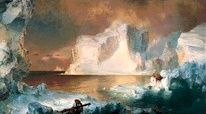
 Hudson River School
- A group of American landscape
painters of the mid-nineteenth century, who took a Romantic
approach to depicting the
Hudson River Valley, and of the Catskill, Berkshire, and White
Mountains, as well as lands further west. As the American frontier
moved westward, the Hudson River painters' views of this expanding
territory found an enthusiastic audience.
Their pictures were often
brashly theatrical, embracing moral or literary associations.
Hudson River School
- A group of American landscape
painters of the mid-nineteenth century, who took a Romantic
approach to depicting the
Hudson River Valley, and of the Catskill, Berkshire, and White
Mountains, as well as lands further west. As the American frontier
moved westward, the Hudson River painters' views of this expanding
territory found an enthusiastic audience.
Their pictures were often
brashly theatrical, embracing moral or literary associations.
Many painters of this school were
influenced by their reading of a book, Essay on the Nature
and Principles of Taste by Archibald Alison. In his book Alison
claims that the beauty and grandeur of unspoiled nature can inspire
good moral qualities.
Examples of their works:
Listed chronologically by artist's birth year
Use ctrl-F (PC) or command-F (Mac) to search for a name
Thomas Birch (American, 1779-1851), The Narrows, New York Bay, 1812, oil on wood panel, 20 x 26 3/4 inches (50.8 x 68 cm), Fine Arts Museums of San Francisco, CA.
Thomas Doughty (American, 1793-1856), Denning's Point, Hudson River, c. 1839, oil on mounted canvas, 24 x 30 inches (60.96 x 76.20 cm), Butler Institute of American Art, Youngstown, OH.

Asher B. Durand (American, 1796-1886), The Beeches, 1845, oil
on canvas, 60 3/8 x 48
1/8 inches (153.4 x 122.2 cm), Metropolitan Museum of Art, NY.

Asher B. Durand, Kindred Spirits,
1849, oil on canvas,
44 x 36 inches. Durand represented
the naturalistic strain
of the Hudson River School. Kindred Spirits is a portrait in nature of the painter Thomas Cole with
his friend, the poet William Cullen Bryant.
Asher Brown Durand, A River Landscape, 1858, oil on canvas, 32 x 48 inches, Fine Arts Museums of San Francisco, CA.
Thomas Cole (American, 1801-1848), The Subsiding of the Waters of the Deluge, 1829, oil on canvas, 35 3/4 x 47 5/8 inches (90.8 x 121.4 cm), National Museum of American Art, Washington, DC.
Seth Eastman (American, 1808-1875), Hudson River with a Distant View of West Point (View of the Highlands from West Point), 1834, oil on canvas, 33 x 50 inches (83.82 x 127.00 cm), Butler Institute of American Art, Youngstown, OH.
John Frederick Kensett (American, 1816-1872), Sunrise among the Rocks of Paradise, Newport, 1859, oil on canvas, 18 x 30 inches (46.1 x 76.2 cm), Fine Arts Museums of San Francisco, CA. See Luminism.
John Frederick Kensett, Rondout Creek, 1862, oil on canvas, New Britain Museum of Art, CT.
T. P. Rossiter (American, 1818-1871),

T. Worthington Whittredge (American, 1820-1910),
Fight Below the Battlements, 1849, oil on canvas,
Kresge Art Museum. Toward the horizon on the left side of the
picture — its deepest portion -- displays Whittredge's use of
aerial perspective.
W. L. Sonntag (American, 1822-1900)
Jasper Francis Cropsey (American, 1823-1900), Lake Wawayanda, Sussex County, New Jersey, 1870, oil on canvas, New Britain Museum of Art, CT.
Jasper Francis Cropsey, Sailing (The Hudson at Tappan Zee), 1883, oil on canvas, 14 x 24 inches (35.56 x 60.96 cm), Butler Institute of American Art, Youngstown, OH.

Sanford Robinson Gifford (American, 1823-1880),
Kauterskill Clove, 1862, oil
on canvas, 48 x 39 7/8
inches (121.9 x 101.3 cm), Metropolitan Museum of Art, NY.
George Inness (American, 1825-1894)

Frederic Edwin Church (American, 1826-1900),
The Icebergs, 1861, oil
on canvas, 64 1/2 x 112
1/2 inches (163.8 x 285.8 cm), Dallas Museum of Art.
Frederic Edwin Church, In the Andes, 1878, oil on canvas, 15 3/16 x 22 3/16 inches (38.57 x 56.35 cm), Butler Institute of American Art, Youngstown, OH.

Albert Bierstadt (American, 1830-1902), The Rocky Mountains, Lander's Peak, 1863,
oil on canvas,
73 1/2 x 120 3/4 inches (186.7 x 306.7 cm), Metropolitan Museum
of Art, NY.
F.A. Silva (American, 1835-1886)
Thomas Moran (American, 1837-1926)
Also see allegory and Luminism.
https://inform.quest/_art